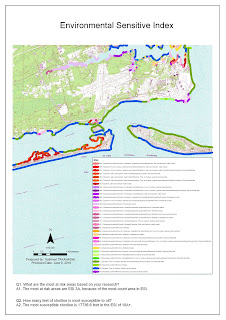
Oct 3, 2010
Jul 24, 2010
Week 10 - Analyzing Data for HLS Planning and Operation
The following map and graphs is showing two line-of-sights to the surveillance position at the entrance of NORAD and their profile graphs.

Following map is showing two protective security buffer zones. One is at the entrance of NORAD with 3 miles buffers. Other is at the Cheyenne Mountain Airport with 500 feet buffers.


Following map is showing two protective security buffer zones. One is at the entrance of NORAD with 3 miles buffers. Other is at the Cheyenne Mountain Airport with 500 feet buffers.

Jun 23, 2010
Week 6 - Location Decisions
Following figure presets calculated distances from NFRMC adn UF. analyzed neighborhood environments about a percentage of people 40 to 49 years old and house values.

Following figure presents the results of a weighted overlay with each factor weighted at 25 percent, and distance factors weighted at 40 percent and a neiborhood environment factors weighted at 10 percent.


Following figure presents the results of a weighted overlay with each factor weighted at 25 percent, and distance factors weighted at 40 percent and a neiborhood environment factors weighted at 10 percent.

Jun 13, 2010
Week 2 - 4 Natural Hazards: Participation Activity
Following is the summary of the role of the GIS in the disaster response.
1) GIS makes a map for the describes what and where has happen.
2) Maps made by GIS make me think about how I can help there.
3) GIS helps clarify where and what help is needed.
1) GIS makes a map for the describes what and where has happen.
2) Maps made by GIS make me think about how I can help there.
3) GIS helps clarify where and what help is needed.
Deepwater Horizon Oil Extent Animation
This animation shows the deepwater horizon oil extent from 24th April, 2nd May, 10th May, 17th May, 20th May and 26th May. We can understand how oil spill was expanded and how many areas were covered in the Gult of Mexico. This information will support to the waterkeeper which area wil be affected by the oil spill expantion.
Jun 9, 2010
Jun 2, 2010
Week 3 - Coastal Flooding From Hurricane Katrina

This map is showing flooded land by the land-cover types with the table calculated area by acres and square miles. The Add Table to Layout command on the Attribute Table window was used to make a table. The Turn Field Off command is useful to hide no necessary field on the attributes.

This map is showing flooded land by land cover types. Attached vertical bar graph describes the percentage of them. The Create Graph Wizard in the Tools menu is easy to create several graphs. Note that it needs enough area in the horizontal direction because of showing the x label field completely.
Apr 11, 2010
Week 11-Labels, Spatial Analyst & 3D Analyst
Mar 24, 2010
Week 9 - Vector Analysis II (Buffers and Overlay)

Q1: Which tool did you use?Was there any noticeable difference between its results and the results from
the instructions?
A1: I used Intersect tool. This tool doesn't include both attribute of layers on the result from the instruction. Only the result appears common in both attribute.
Q2: Which tool did you use here? Why?
A2: I used Erase tool. Because this tool can exclude conservation areas from Buffers_union_single layer.
Q3: How many features are in this layer? What is the area of the largest feature? What is the area of the smallest feature?
A3: They are 79 features. The area of the largest feature is 7,765,034 square meters. The area of smallest feature is 748 square meters.
Mar 11, 2010
Mar 1, 2010
Feb 24, 2010
Feb 21, 2010
Feb 10, 2010
Participation: Haiti Earthquake Discussion
I found this map at the Cartographic Section, United Nations Web Site. (ftp://157.150.195.135/Maps/DamageAssessment/PAP_assessmentmap_overview_block.pdf)
This map shows the results of damage assessement conducted by the United Nations Stabilization Mission in Haiti (MINUSTAH)(http://www.un.org/en/peacekeeping/missions/minustah/index.shtml)
This map serves a purpose of where is the most damaged place and the victims gathered in Port Au Prince.
I think this map useful for the site selection to deliver relief goods to the victims immediately.

I found this map at the Cartographic Section, United Nations Web Site. (ftp://157.150.195.135/Maps/DamageAssessment/PAP_assessmentmap_overview_block.pdf)
This map shows the results of damage assessement conducted by the United Nations Stabilization Mission in Haiti (MINUSTAH)(http://www.un.org/en/peacekeeping/missions/minustah/index.shtml)
This map serves a purpose of where is the most damaged place and the victims gathered in Port Au Prince.
I think this map useful for the site selection to deliver relief goods to the victims immediately.

Feb 9, 2010
Feb 3, 2010
Jan 26, 2010
Subscribe to:
Comments (Atom)


















